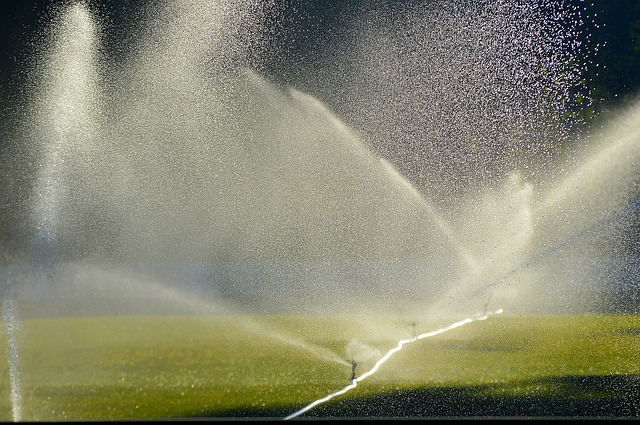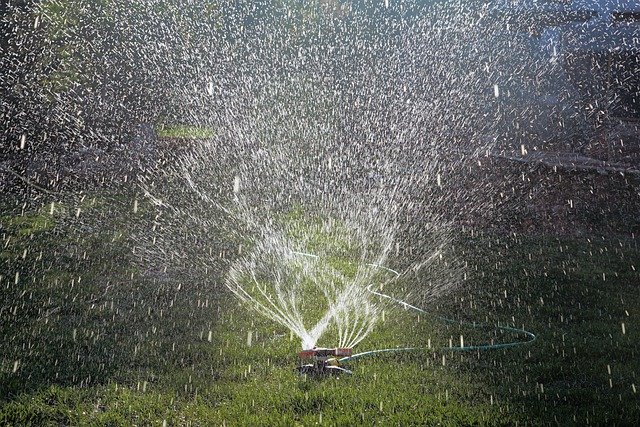~ Deep Watering Grass ~
How to Water Mature Turf
Deep watering grass is different from watering a new lawn. Proper irrigation techniques can be the difference between a healthy beautiful lawn or a diseased, dead or dying lawn. In fact, the correct method of watering a mature lawn is often far different from what most people think. This page will explain the how's and why's of deep watering grass. Mature grass by definition means grass that is well beyond the seedling stage. It can be less than one year old to many years old.
All plant life must have water. It is essential. But you can actually irrigate too much that can lead to serious problems including diseases or irrigate too little, which can also cause problems such as thinning or die back. Below is some of the basic science behind watering mature grass.
The Grass Crown
Once seed has germinated and begins to draw moisture and nutrients from the soil the grass crown will take over as the life center of the plant. The white thick area of the grass at ground level is called the crown and is considered the "brain" of the grass.
From the crown, green grass grows up from the crown and roots grows down into the soil. Yet, while this "brain" controls many functions of grass growth, it cannot think. It can only perform genetic responses to circumstances it's place in. These circumstances range from the amount of water and sunlight the plant receives, to disease problems, to temperature and nutrient uptake, etc.
Grass will not perform essential functions, such as growing deeper roots, unless there are conditions that force it to do so. For example, if you consistently over-water the grass to the point the ground is almost continually wet, the grass is able to get enough water from shallow roots and is not triggered to grow deeper roots.
Therefore, with frequently watered or over-watered grass, the grass crown will not send out signals to grow deeper roots. Shallow roots will come with its own set of problems. Shallow soil heats up quickly and dries out more rapidly which can damage roots over time.
It means the grass is less able to handle stress during drought conditions. In warm season grass, shallow roots will often grow only in the thatch and not in the soil, which can harm or eventually kill the grass. Shallow rooting often exists where homeowners have automatic sprinklers set either once or multiple times each day for extended periods.
The How's and Why's of Deep Watering Grass
The following is standard turf science that is recommended for clay or loamy soils with both warm season and cool season grasses. The first step in getting deeper roots, on loam or clay loam soils, is the mature grass soil around the roots should be allowed to dry out to the point it reaches a low to medium stress level.
I can't stress this enough that many people that take pride in their yard would never allow this to happen, yet they need to. Most people think they are hurting the grass and won't wait this long. But the grass will begin showing signs of starting to wilt. This will scare some people into watering, but hold off still. Again, this is for loamy soils.
Something occurs inside grass as a response to drought. As grass begins to become drought stressed, it produces a hormone chemical called Abscisic Acid or ABA. (Dr. Nick Christians, Fundamentals of Turfgrass Management)
The deeper the drought, the more hormone it makes. The acid signals the stomata to close keeping moisture inside the plant longer. With less energy going to the blades, the grass refocuses its energy on the roots. The slower growth thickens the cuticle (grass leaf surface) and signals the roots to develop a more extensive root system by growing deeper and more extensively into the soil.
You can tell if the grass needs to be watered deeply by a change in the color of the grass as the blades fold. If you walk on the grass, it doesn't immediately spring back but will take longer to become upright again. You can look back and see your foot prints. Then deep watering grass process should begin by watering deeply over a couple days.
When This Method Doesn't Work
If you have a sandy soil, heavy and deep watering will not work, depending on the sand content. The soil just doesn't have the ability to hold the moisture like a loamy soil does. More frequent watering using less water is necessary.
Also in grass that is still young, recently planted or over-seeded this method may not work. On newly seeded soil the plant is too young and is not able to respond to pressure the way mature grass can. Water more often and more frequently or damage to your young turf may occur.
Deep Watering Grass and Sprinkler Types
Not all sprinklers are equal. Some are more efficient in getting water to the grass than others. Water pressure is also a factor. You may have a private in-ground well that works great for the house, but for watering the grass it may lack water pressure. Others may have terrific water pressure where they live.
For low pressure systems, find a sprinkler that puts more water in a shorter diameter. You will soak the grass, so expect to move it more often. The small, low profile sprinkler that has 30 - 40 small holes in the center and sprays 20 ft in diameter works well for low pressure. The oscillating sprinkler that shoots water in a arc fashion is the least efficient in my opinion.
For high pressure, impact sprinklers can put out a lot of water over greater distances. These are used on Golf Courses and Sports fields. You will have to decide what is best for you.
If you have a built-in sprinkler system, make sure it covers all of the grass. Do not set it on a timer. Keep a watch on the grass condition and water as necessary. If you have dry spots you may have to water those by hand or use a portable sprinkler and hose.
Deep Watering Grass to Lawn Care Academy Home


